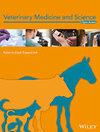出生类型和性别对生长中的古尔库山羊幼崽的生长性能、躯干高度、肱骨半径骨骼尺寸、肱骨外侧生长板宽度和所选激素谱的影响
IF 1.7
3区 农林科学
Q2 VETERINARY SCIENCES
引用次数: 0
摘要
目的 本研究调查了性别和出生类型对 Gurcu 山羊幼崽的生长性能、胸围(WH)、X 射线测量值和某些激素谱的影响。方法 本研究纳入了 20 个幼崽(单雌=5、单雄=5、双雌=5、双雄=5)。体重(BW)、体温(WH)、放射学测量(肱骨长度[HL]、桡骨长度[RL]、肱骨近端骺板宽度[HEP]和尺骨远端骺板宽度[UEP])和生化分析(血清降钙素、游离三碘甲状腺原氨酸[FIT]、血清降钙素、游离三碘甲状腺原氨酸[FIT])、游离三碘甲状腺原氨酸 [FT3]、游离甲状腺素 [FT4]、生长激素 [GH] 和胰岛素样生长因子-I [IGF-I])。结果 从第七个月开始,雄性的体重明显高于雌性(p <0.05)。雄性在七个月(p = 0.009)和九个月(p = 0.033)时HL较高,而双胞胎在第三个月时RL较低(p = 0.021)。男性在 7 个月(p = 0.008)和 9 个月(p = 0.036)时,UEP 较宽。65% 的孩子在第 12 个月时 HEP 闭合。双胞胎的降钙素在第三个月(p = 0.045)和第五个月(p = 0.006)时较低,观察到的变化是由组别和时间效应引起的(p < 0.05),而其他激素仅随时间变化(p < 0.05)。体重、WH、HL、RL 和 IGF-I 之间呈正相关。结论Gurcu山羊幼崽的性别和出生类型可能会对生长性能、放射学测量和某些激素谱产生影响。本文章由计算机程序翻译,如有差异,请以英文原文为准。
Effect of birth type and sex on growth performance, wither height, humerus‐radius bone dimensions, humerus–ulna growth plate width and selected hormone profile in growing Gurcu goat kids
ObjectivesIn this study, the effects of sex and birth type on growth performance, withers height (WH), radiographic measurements and selected hormone profiles in Gurcu goat kids were investigated.MethodsTwenty kids (single female = 5, single male = 5, twin female = 5, twin male = 5) were included in the study. Body weight (BW), WH, radiographic measurements (humerus length [HL], radius length [RL], proximal humerus epiphyseal plate width [HEP] and distal ulna epiphyseal plate width [UEP]) and biochemical analysis (for serum calcitonin, free triiodothyronine [FT3], free thyroxine [FT4], growth hormone [GH] and insulin‐like growth factor‐I [IGF‐I]) were performed at 1, 3, 5, 7, 9 and 12 months of age.ResultsBW was significantly higher in males starting from the seventh month compared to females (p < 0.05). HL was higher in males at seventh (p = 0.009) and ninth (p = 0.033) months, whereas RL was lower in twins at the third month (p = 0.021). UEP was wider in males at seventh (p = 0.008) and ninth (p = 0.036) months. Closure of HEP was observed in 65% of kids by the 12th month. Calcitonin was lower in twins at third (p = 0.045) and fifth (p = 0.006) months, with changes observed due to group and time effects (p < 0.05), whereas other hormones only changed with time (p < 0.05). Positive correlations were observed between BW, WH, HL, RL and IGF‐I. There was a negative correlation between BW, WH, HL, RL, IGF‐I and HEP, UEP, calcitonin, FT3, FT4, GH.ConclusionSex and birth type in Gurcu goat kids may have an impact on growth performance, radiographic measurements and certain hormonal profiles.
求助全文
通过发布文献求助,成功后即可免费获取论文全文。
去求助
来源期刊

Veterinary Medicine and Science
Veterinary-General Veterinary
CiteScore
3.00
自引率
0.00%
发文量
296
期刊介绍:
Veterinary Medicine and Science is the peer-reviewed journal for rapid dissemination of research in all areas of veterinary medicine and science. The journal aims to serve the research community by providing a vehicle for authors wishing to publish interesting and high quality work in both fundamental and clinical veterinary medicine and science.
Veterinary Medicine and Science publishes original research articles, systematic reviews, meta-analyses, and research methods papers, along with invited editorials and commentaries. Original research papers must report well-conducted research with conclusions supported by the data presented in the paper.
We aim to be a truly global forum for high-quality research in veterinary medicine and science, and believe that the best research should be published and made widely accessible as quickly as possible. Veterinary Medicine and Science publishes papers submitted directly to the journal and those referred from a select group of prestigious journals published by Wiley-Blackwell.
Veterinary Medicine and Science is a Wiley Open Access journal, one of a new series of peer-reviewed titles publishing quality research with speed and efficiency. For further information visit the Wiley Open Access website.
 求助内容:
求助内容: 应助结果提醒方式:
应助结果提醒方式:


